Tegernsee
| Tegernsee | ||
|---|---|---|
|
Panorama of the town from across the lake | ||
| ||
 Tegernsee | ||
Location of Tegernsee within Miesbach district 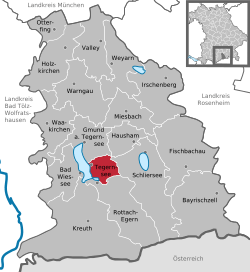 | ||
| Coordinates: 47°42′N 11°46′E / 47.700°N 11.767°ECoordinates: 47°42′N 11°46′E / 47.700°N 11.767°E | ||
| Country | Germany | |
| State | Bavaria | |
| Admin. region | Oberbayern | |
| District | Miesbach | |
| Government | ||
| • Mayor | Johannes Hagn (CSU) | |
| Area | ||
| • Total | 22.77 km2 (8.79 sq mi) | |
| Elevation | 747 m (2,451 ft) | |
| Population (2015-12-31)[1] | ||
| • Total | 3,880 | |
| • Density | 170/km2 (440/sq mi) | |
| Time zone | CET/CEST (UTC+1/+2) | |
| Postal codes | 83684 | |
| Dialling codes | 08022 | |
| Vehicle registration | MB | |
| Website | rathaus-tegernsee.de | |
Tegernsee is a town in the Miesbach district of Bavaria, Germany. It is located on the shore of Tegernsee lake, at an elevation of 747 m (2,451 ft) above sea level.
The town has its origins in the Tegernsee Abbey, which was founded in 746. Today it is considered a spa town, surrounded by an alpine landscape. The economy is mainly based on tourism.
Tegernsee is located on the Bundesstraße 307, which runs from Gmund am Tegernsee to the Sylvenstein Dam. It is also the terminus for the Tegernsee-Bahn railway.
History
The original settlers of the area around the Tegernsee lake were Illyrians who arrived in the early Stone Age. The recorded history of the region and of the town began with the arrival of the Bavarians in the 6th century AD. The noble family of the Agilolfings ruled this region and the entire Duchy of Bavaria.[2]
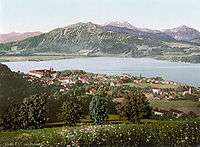
The Benedictine Abbey of Tegernsee was founded in 746 by the brothers Adalbert and Ottokar, of the noble family of Huosi. The abbey's name derives from Old High German tegarin seo, meaning "large lake".[3] Although much of the town's early history is unknown as a result of Magyar incursions in the 10th century, it is known that relics of St Quirinus, which the abbey's founders obtained from Pope Paul I, were transferred in the 8th century from Rome to Tegernsee to be placed in its first church. The monastery had a substantial influence on the development of Southern Bavaria during the Middle Ages. It fell into decay in 907 after a series of defeats by the Magyars. It was secularized in 921 by Duke Arnulf and re-established in 979 by Emperor Otto II and Duke Otto I of Bavaria. The emperor appointed a new abbot and granted the rights of free election of the abbot, freedom from taxes and imperial protection. Thus removed from the suzerainty of the Bavarian rulers, the abbey recovered its prosperity[4] and grew culturally and artistically. Workshops were founded for book and glass painting and for goldsmithing. Around 1030 Ruodlieb, an early German romance of knightly adventure written in Latin verse, was almost certainly written there. In 1165 Holy Roman Emperor Friedrich I visited the abbey. In the fifteenth century, Cardinal Nicholas of Cusa corresponded with the abbot and prior about issues including mystical theology.
Because of its naturally protected position, Tegernsee suffered less from war and hardship than other parts of Bavaria. However, it was infested by the Black Death during the Thirty Years' War. The monastery was secularized in 1803 and was acquired by the Bavarian royal family, the Wittelsbachs, who made it their summer residence. They brought court life and visitors to the lake, starting the tourism that characterizes the area today.[5] The town experienced tribulations during the War of the Austrian Succession and suffered many casualties in wars from the Austro-Prussian War in 1866 until World War II.[2] The abbey buildings were used as a military hospital during World War II. The valley was overcrowded with evacuees, who were there for protection from the bombing of urban areas. In the final weeks of the war, an SS division moved into the valley and built defenses against the American forces advancing from Bad Tölz. On May 3, 1945, as American artillery prepared to open fire on the town, a wounded officer in the German army, Maj. Hannibal von Lüttichau, who was recovering in the makeshift military hospital, persuaded the SS to withdraw in order to save the town and its large population of noncombatants from the imminent bombardment. After persuading the SS to withdraw from the town, the Major advanced unarmed, in uniform, and alone towards the American forces under a white flag and convinced the commanding officer to spare the town. [6]
Geography
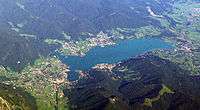
Tegernsee is in the Miesbach district in the Bavarian Alps, on the east shore of its eponymous lake, neighbouring Gmund am Tegernsee and Hausham to the north, Schliersee to the east and Rottach-Egern to the south. The Bavarian state capital, Munich, is about 50 km (31 mi) north of the town, and the Austrian state of Tyrol is about 20 km (12 mi) south.
The Alpbach stream, whose bed it was planned to clean up in 2010, runs through the center of Tegernsee.[7] The Rottach river flows partly along the boundary between the communities of Tegernsee and Rottach-Egern. The Baumgartenschneid, a 1,448 metre mountain, is located not far from the town.
At the 2010 census, Tegernsee had a population of 3,889, of whom 1,672 were male and 2,217 female.[8]
Attractions

The former Benedictine Abbey of Tegernsee is open to visitors. The complex is composed of the parish church of Saint Quirinus, the former abbey church, and the adjacent north and south wings surrounding the two courtyards. The north wing hosts the Herzoglich Bayerisches Brauhaus Tegernsee (Ducal Bavarian Brewery of Tegernsee), one of Germany's oldest breweries.[9] The entire complex is called Schloss Tegernsee and has been owned by the Wittelsbach family since 1817.[10]
Other historic buildings include the houses of writer Ludwig Ganghofer and painter Joseph Karl Stieler, and the summer residence of Lord Acton. The Olaf Gulbransson Museum has been open since 1966 and is dedicated to the art of the Norwegian painter and caricaturist Olaf Gulbransson[11] The Museum Tegernseer Tal was established in 1999 in the Old Rectory of Tegernsee. It has 17 exhibition rooms, and its theme is the history and culture of the Tegernsee valley from the Middle Ages to the present.[12] The Tegernseer Volkstheater has been in use since 1898.[13]
The area around the Tegernsee lake serves as a recreational area.[14] It is surrounded by the Bavarian Alps and occupies about 9 km2 (3.5 sq mi).[15] It offers aquatic sports such as swimming and fishing, and other activities including hiking and Nordic walking.[16] One can climb the 700 metres to the top of the Baumgartenschneid: the ascent takes 2 hours and the descent 1½ hours.[17]
Economy
Tourism plays an important part in the economy of the city and the district.[18] The local Orthopedic Clinic is the town's largest employer.[19] Since 2003 the city has hosted the annual Tegernsee International Mountain Film Festival, in which movies depicting life in the mountains compete.[20]
Transport
Tegernsee is on the Bundesstraße 307, which runs from Gmund am Tegernsee to the Sylvenstein Dam. The Bundesautobahn 8 passes about 20 km to the north. The 9559 Tegernsee-Ringlinie bus connects Tegernsee with Rottach-Egern, Bad Wiessee and Gmund am Tegernsee.[21]
The railway station is the terminus of the privately owned Tegernsee-Bahn and is linked to Munich by through trains of the Bayerische Oberlandbahn. It is also a principal stop for the pleasure boat services operated on the lake by the Bayerische Seenschifffahrt company.[22]
Politics
Coat of arms
The coat of arms of Tegernsee is divided into four quarters: the upper left and lower right quarters each depict three golden crowns on a blue background; the other two quarters depict water-lily leaves with entwined stalks above blue waves on a silver background. It was granted in 1886 and is based on the coat of arms of Tegernsee Abbey from 1565.[23]
Twin towns
In 2006 Tegernsee twinned with Dürnstein, an Austrian town on the Danube.[24]
![]() Dürnstein, Austria
Dürnstein, Austria
Sports
Tegernsee is the home town of Viktoria Rebensburg, an alpine ski racer who won the gold medal in the women's giant slalom at the 2010 Winter Olympics,[25] and won the giant slalom title in the 2011 Alpine Skiing World Cup.
The town is also home to the sports association TV Tegernsee, whose chess club plays played until the 2008/09 season in the first division of the German Bundesliga.[26][27]
Notable residents
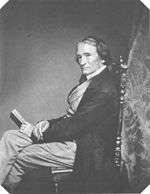
- Joseph Karl Stieler, (1781-1858), painter in the service of the Bavarian court.[28]
- Karl Stieler (1842-1885), jurist and poet; Buried in the Tegernsee cemetery
- Oskar Messter (1866-1943), filmpionier, buried in the Tegernsee cemetery
- Ludwig Thoma (1867-1921), lived since 1908 in his house "Auf der Tuften" in Tegernsee, where he also died
- Hedwig Courths-Mahler (1867-1950), had lived in her house at Schwaighofstraße 47 since 1935, where she also died
- August Macke (1887-1914), painter and member of the artist group Der Blaue Reiter, lived and painted from 1909 to 1910 a year in Tegernsee
- Karl von Eberstein (1894-1979), German politician (NSDAP) and former list of Munich police officers of the Munich police lived since 1950 in Tegernsee and found his last retirement at the Tegernseer cemetery
- Olaf Gulbransson, (1873-1958), Norwegian painter and caricaturist.[11]
- Viktoria Rebensburg, (born 1989), alpine ski racer, giant slalom gold medallist in the 2010 Winter Olympics.[29]
- Ludwig Ganghofer, author.[30]
- British peer and historian John Dalberg-Acton, 1st Baron Acton, died there in 1902 at his wife's family home.[31]
Sons and daughters of the town
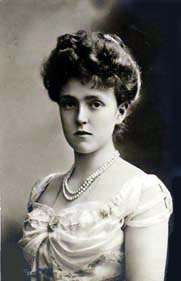
- Egid Quirin Asam (1692-1750), plasterer and sculptor of the late Baroque
- Joseph Kriechbaumer (1819-1902), zoologist (Entomologist).
- Duchess Marie Gabrielle in Bavaria (1878-1912), daughter of Duke Karl Theodor, Duke in Bavaria
- Marianne Seltsam (1932-2014), German ski racer
- Max Leo (1941-2012), luger
- Eva Mattes (born 1954), Austrian actress
- Wolfgang Lackerschmid (born 1956), jazz musician
- Michael Veith (born 1957), ski racer
- Mirko Bonné (born 1965), writer and translator
- Peter Schlickenrieder (born 1970), cross-country skier
- Marcus H. Rosenmüller (born 1973), film director
- Florian Busch (born 1985), ice hockey player
References
- ↑ "Fortschreibung des Bevölkerungsstandes". Bayerisches Landesamt für Statistik und Datenverarbeitung (in German). June 2016.
- 1 2 "Geschichte". Tegernsee's Government Site (in German). Tegernsee's Government. Retrieved 14 May 2017.
- ↑ "Der See mit Geschichte". Tegernsee's Official Site (in German). Tegernsee's Government. Archived from the original on 28 August 2011. Retrieved 7 September 2011.
- ↑ "Tegernsee". Catholic Encyclopedia. Retrieved 8 September 2011.
- ↑ "Der See mit Geschichte". Gmund am Tegernsee's Government Site (in German). Gmund am Tegernsee's Government. Archived from the original on 5 September 2011. Retrieved 8 September 2011.
- ↑ "In Germany, War and Reunion:German Town Where Opposing Soldiers Prevented Destruction". The New York Times. The New York Times. May 26, 2010. Retrieved May 22, 2015.
- ↑ "Der Alpbach in Tegernsee fließt – vorläufig aber nur durch zwei Rohre". Tegernseer Stimme (in German). 16 November 2010. Retrieved 7 September 2011.
- ↑ "Bevölkerung: Gemeinden, Geschlecht, Quartale, Jahr". Bavarian Office of Statistic and Data Processing (in German). Retrieved 14 September 2011.
- ↑ "Patenfirma Herzoglich Bayerisches Brauhaus Tegernsee" (in German). Bayerische Brau AG. Retrieved 7 September 2011.
- ↑ "Geschichte". Gymnasium Tegernsee (in German). Archived from the original on 13 November 2011. Retrieved 7 September 2011.
- 1 2 "Olaf Gulbransson". Olaf Gulbransson Museum's Site (in German). Olaf Gulbransson Museum. Retrieved 14 September 2011.
- ↑ "Das Museum Tegernseer Tal". Tegernsee's Site (in German). Tegernsee's town Government. Archived from the original on 2 April 2012. Retrieved 14 September 2011.
- ↑ "Volkstheater". Tegernsee's Site (in German). Tegernsee's town Government. Archived from the original on 28 September 2011. Retrieved 14 September 2011.
- ↑ "Abschalten und Kraft tanken". Tegernsee's Official Site (in German). Tegernsee's Government. Retrieved 2011-07-11.
- ↑ "Tegernsee (lake, Germany)". Encyclopædia Britannica. Encyclopædia Britannica's online version. Retrieved 2011-07-11.
- ↑ "Tegernsee". Munich's Official Site. Munich's city Government. Retrieved 2011-07-11.
- ↑ Wecker, Evamaria; Stitzinger, Luis (2002). Bergtouren mit Bus & Bahn, Bayerische Alpen (in German). Verlag Geobuch. p. 147. ISBN 3-925308-09-1.
- ↑ "Alpenregion Tegernsee Schliersee". Miesbach district's Official Site (in German). Miesbach district's Government. Retrieved August 10, 2011.
- ↑ "Orthopädische Klinik: Neubau am alten Standort". Münchner Merkur (in German). Die Merkur Online. July 7, 2011. Retrieved August 10, 2011.
- ↑ "9th Tegernsee International Mountain Film Festival". Bergfilm Festival Tegernsee (in German). Die Merkur Online. July 7, 2011. Archived from the original on September 5, 2011. Retrieved August 10, 2011.
- ↑ "Ringlinie 9559 Tegernsee – Gmund, Bad Wiessee – Rottach-Egern – Tegernsee" (PDF) (in German). Regionalverkehr Oberbayern. Archived from the original (PDF) on 2011-05-17. Retrieved 2011-09-04.
- ↑ "Bayerische Seenschifffahrt" (in German and English). Bayerische Seenschifffahrt. Retrieved 2011-07-11.
- ↑ Mages, Emma. "Bayerns Gemeinden". Haus der Bayrischen Geschichte (in German). Retrieved September 8, 2011.
- ↑ Tegernseer Nachrichten (PDF) (in German). Tegernsee's Town Government. February 2008 http://www.rathaus-tegernsee.de/cms/filewrapper.php?md5id=8d7cc15faf655897f9286da10249e5e3&media_id=229&path=/Nachrichten%20Feb%2006%20.pdf. Retrieved September 4, 2011. Missing or empty
|title=(help) - ↑ Ski Racing.com – Olympics: Rebensburg gets GS gold, Mancuso eighth – 2010-02-25
- ↑ "Schachklub Tegernsee Startseite". TV Tegernsee's chess club Official Site (in German). TV Tegernsee. Retrieved August 10, 2011.
- ↑ "Schachticker" (in German). Retrieved May 6, 2014.
- ↑ "Monument to Joseph Karl Stieler in Tegernsee". Historisches Alpenarchiv (in German). TV Tegernsee. Retrieved 14 September 2011.
- ↑ "Gold für Rebensburg". Mein Tegernsee (in German). 25 February 2010. Retrieved 14 September 2011.
- ↑ "Ludwig Ganghofer und Tegernsee". Kaufbeuren town's Site (in German). Kaufbeuren town's Government. Retrieved 14 September 2011.
- ↑ Mee, Arthur (1946). The King's England; Shropshire. Hodder & Stoughton. p. 153.
External links
| Wikimedia Commons has media related to Tegernsee. |
-
 Tegernsee travel guide from Wikivoyage
Tegernsee travel guide from Wikivoyage - Tegernsee.com – (in English)

